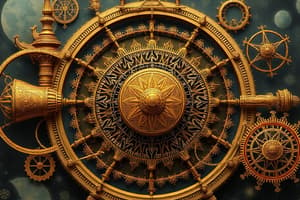Podcast
Questions and Answers
What is the relationship between force, mass, and acceleration, according to Newton's second law?
What is the relationship between force, mass, and acceleration, according to Newton's second law?
- Force is directly proportional to both mass and acceleration. (correct)
- Force is directly proportional to mass and inversely proportional to acceleration.
- Force is inversely proportional to mass and directly proportional to acceleration.
- Force is inversely proportional to both mass and acceleration.
Which of these is NOT a key concept in electromagnetism?
Which of these is NOT a key concept in electromagnetism?
- Magnetic flux
- Gravitational force (correct)
- Magnetic forces
- Electric potential
What is the primary difference between reflection and refraction?
What is the primary difference between reflection and refraction?
- Reflection involves a change in the speed of the wave, while refraction does not.
- Refraction involves a change in the speed of the wave, while reflection does not. (correct)
- Refraction involves a change in the direction of the wave, while reflection does not.
- Reflection involves a change in the direction of the wave, while refraction does not.
Which law of thermodynamics states that energy cannot be created or destroyed, only transformed?
Which law of thermodynamics states that energy cannot be created or destroyed, only transformed?
What is the meaning of the term 'entropy' in thermodynamics?
What is the meaning of the term 'entropy' in thermodynamics?
What is the correct equation for Newton's second law of motion?
What is the correct equation for Newton's second law of motion?
Which of the following is NOT an application of thermodynamics?
Which of the following is NOT an application of thermodynamics?
Which of the following is NOT a key concept in optics?
Which of the following is NOT a key concept in optics?
What is the relationship between space and time according to Einstein's theory of special relativity?
What is the relationship between space and time according to Einstein's theory of special relativity?
Which of the following is NOT a key concept in quantum mechanics?
Which of the following is NOT a key concept in quantum mechanics?
What is a consequence of the uncertainty principle in quantum mechanics?
What is a consequence of the uncertainty principle in quantum mechanics?
What is the main difference between special relativity and general relativity?
What is the main difference between special relativity and general relativity?
Which of the following is NOT a consequence of special relativity?
Which of the following is NOT a consequence of special relativity?
Which of the following is an example of a modern physics application?
Which of the following is an example of a modern physics application?
What is the significance of the equation E=mc²?
What is the significance of the equation E=mc²?
How does wave-particle duality influence our understanding of light?
How does wave-particle duality influence our understanding of light?
Flashcards
Interference
Interference
The superposition of two or more waves to form a resultant wave of greater, lower, or the same amplitude.
Polarization
Polarization
A property of transverse waves describing the orientation of their oscillations.
Quantum Mechanics
Quantum Mechanics
A branch of physics dealing with the behavior of matter and energy at the atomic and subatomic levels.
Wave-particle duality
Wave-particle duality
Signup and view all the flashcards
Relativity
Relativity
Signup and view all the flashcards
Special relativity
Special relativity
Signup and view all the flashcards
Uncertainty principle
Uncertainty principle
Signup and view all the flashcards
General relativity
General relativity
Signup and view all the flashcards
Classical Mechanics
Classical Mechanics
Signup and view all the flashcards
Newton's First Law (Inertia)
Newton's First Law (Inertia)
Signup and view all the flashcards
Newton's Second Law (F = ma)
Newton's Second Law (F = ma)
Signup and view all the flashcards
Newton's Third Law (Action-Reaction)
Newton's Third Law (Action-Reaction)
Signup and view all the flashcards
Thermodynamics
Thermodynamics
Signup and view all the flashcards
First Law of Thermodynamics (Conservation of Energy)
First Law of Thermodynamics (Conservation of Energy)
Signup and view all the flashcards
Optics
Optics
Signup and view all the flashcards
Diffraction
Diffraction
Signup and view all the flashcards
Study Notes
Classical Mechanics
- Classical mechanics describes the motion of macroscopic objects.
- It is based on Newton's laws of motion and the concept of forces.
- Newton's first law states that an object at rest stays at rest and an object in motion stays in motion with the same speed and in the same direction unless acted upon by an unbalanced force.
- Newton's second law states that the acceleration of an object is directly proportional to the net force acting on it and inversely proportional to its mass. Mathematically, F = ma, where F is force, m is mass, and a is acceleration.
- Newton's third law states that for every action, there is an equal and opposite reaction.
- Concepts include: momentum, impulse, work, energy, power, and conservation laws.
- Applications range from simple machines to complex systems like planetary orbits.
Thermodynamics
- Thermodynamics deals with heat, work, and temperature, and their relation to energy and entropy.
- Key laws include the zeroth law, the first law (conservation of energy), the second law (entropy increase), and the third law (absolute zero).
- The zeroth law defines thermal equilibrium.
- The first law states that energy can neither be created nor destroyed, only transformed from one form to another.
- The second law explains that spontaneous processes increase the total entropy of an isolated system.
- Applications include heat engines, refrigerators, and understanding phase transitions.
Electromagnetism
- Electromagnetism describes the interactions between electric charges and magnetic fields.
- Key concepts include electric fields, magnetic fields, electric potential, and magnetic forces.
- Coulomb's law describes the force between two point charges.
- Gauss's law relates the electric field to the enclosed charge.
- Ampere's law relates the magnetic field to the current.
- Faraday's law describes electromagnetic induction.
- Applications include motors, generators, transformers, and electromagnetic waves.
Optics
- Optics deals with the behavior of light.
- Key concepts include reflection, refraction, diffraction, interference, and polarization.
- Reflection is the change in direction of a wavefront at an interface between two different media so that the wavefront returns into the medium from which it originated.
- Refraction is the change in direction of a wave passing from one medium to another caused by its change in speed.
- Diffraction is the bending of waves around obstacles or openings.
- Interference is the superposition of two or more waves to form a resultant wave of greater, lower, or the same amplitude.
- Polarization is a property of transverse waves that describes the orientation of their oscillations.
- Applications include telescopes, microscopes, and optical fibers.
Modern Physics
- Modern physics encompasses quantum mechanics and relativity.
- Quantum mechanics describes the behavior of matter and energy at the atomic and subatomic level.
- Key concepts include quantization of energy, wave-particle duality, and the uncertainty principle.
- Relativity deals with the relationship between space and time, and their dependence on motion.
- Special relativity describes the laws of physics for objects moving at constant velocities.
- General relativity describes the laws of physics for objects moving under the influence of gravity.
- Applications include nuclear energy, lasers, and understanding the universe at large scales.
Special Relativity
- Special relativity is a theory of relativity that combines space and time into a four-dimensional spacetime continuum.
- It is based on two postulates: the laws of physics are the same for all observers in uniform motion, and the speed of light in a vacuum is the same for all observers, regardless of the motion of the light source.
- Implications include time dilation, length contraction, and the equivalence of mass and energy (E=mc²).
Quantum Mechanics
- Quantum mechanics is a theory that describes the physical properties of nature at the scale of atoms and subatomic particles.
- Key concepts include wave-particle duality, quantization, and uncertainty principle.
- Wave-particle duality states that matter and energy exhibit properties of both waves and particles.
- Quantization is the observation that some properties of a quantum system can only take on discrete values.
- The uncertainty principle states that certain pairs of physical properties, like position and momentum, cannot both be known precisely.
- Applications include transistors, lasers and atomic clocks.
Studying That Suits You
Use AI to generate personalized quizzes and flashcards to suit your learning preferences.




